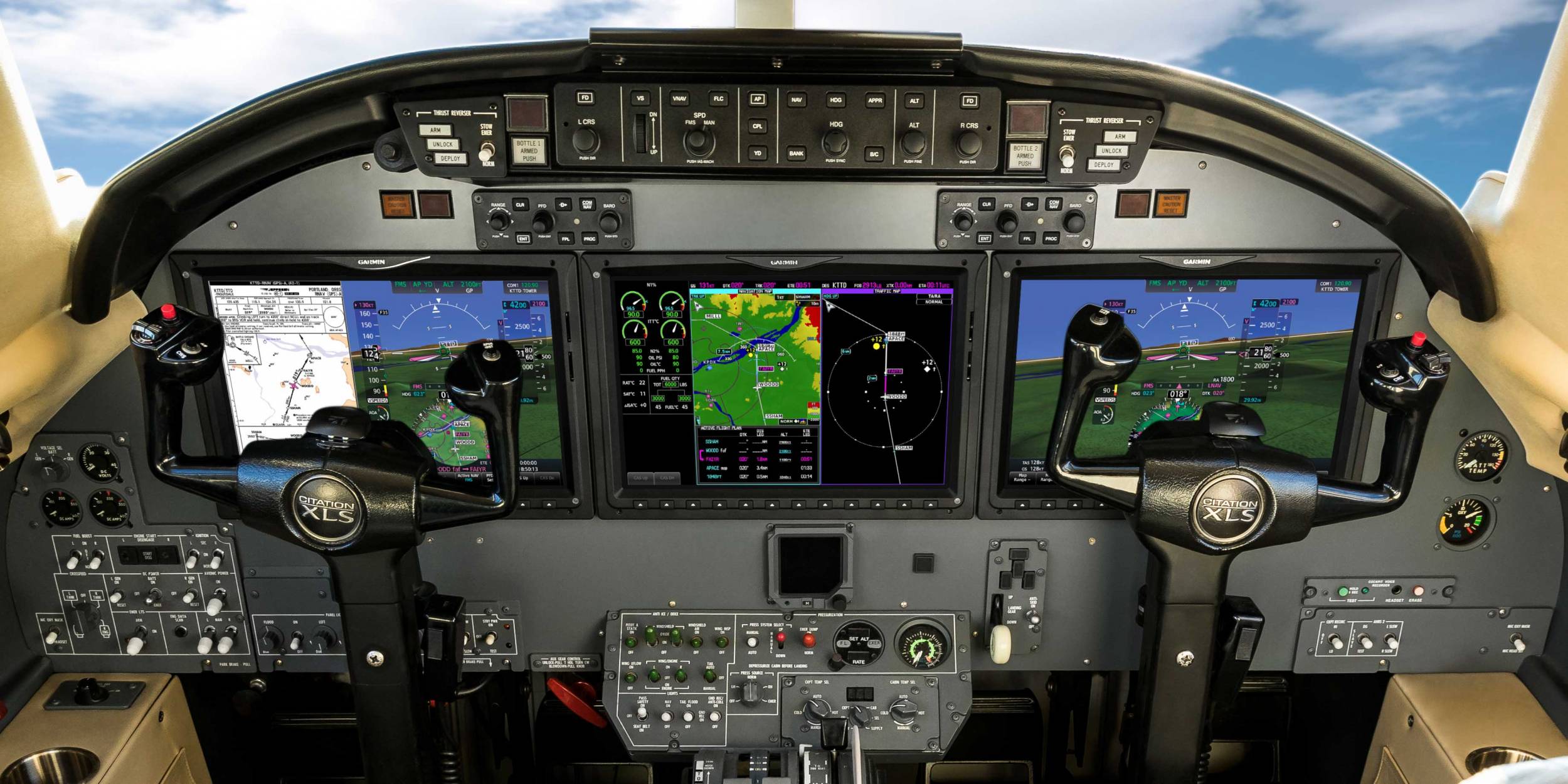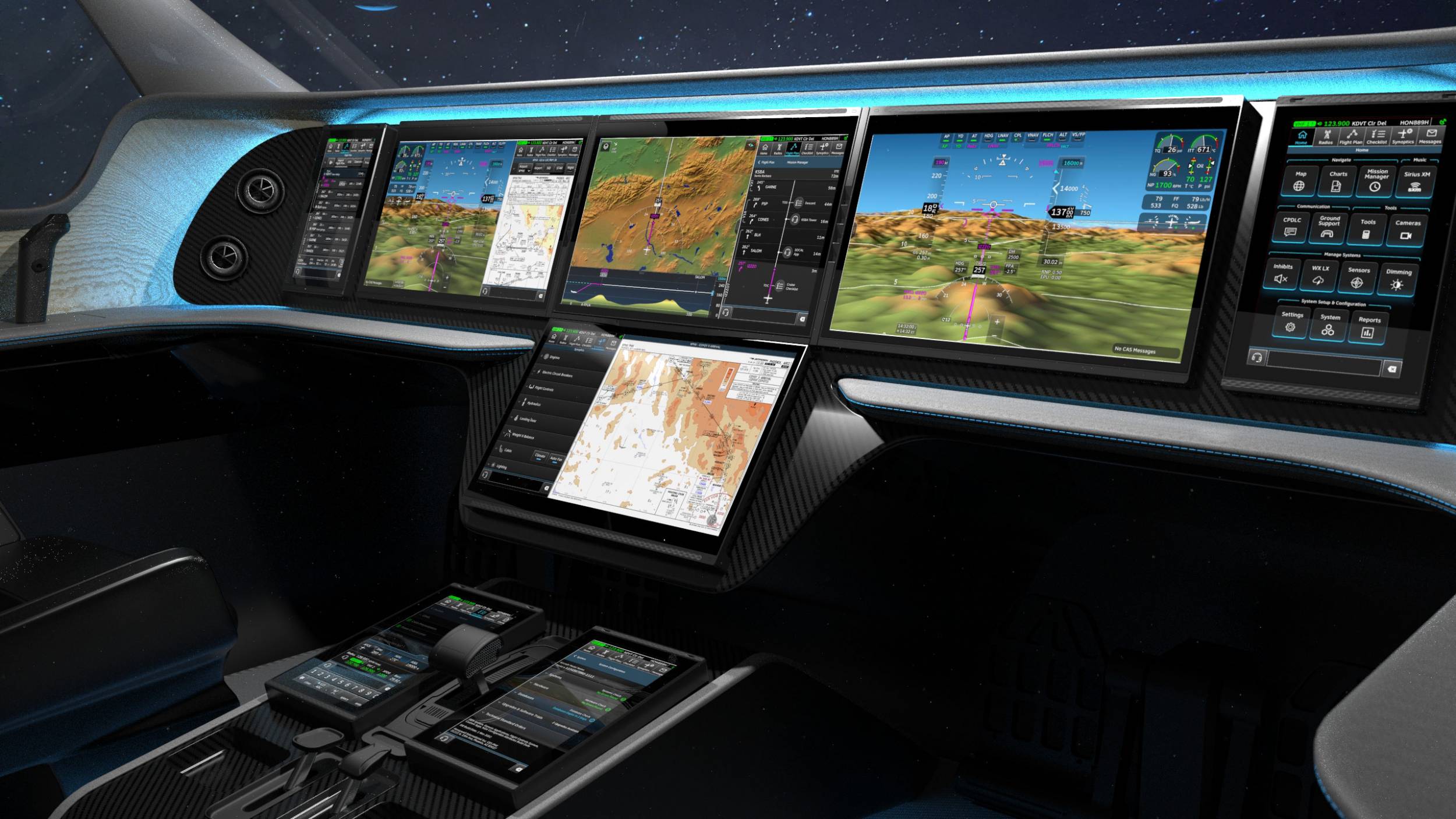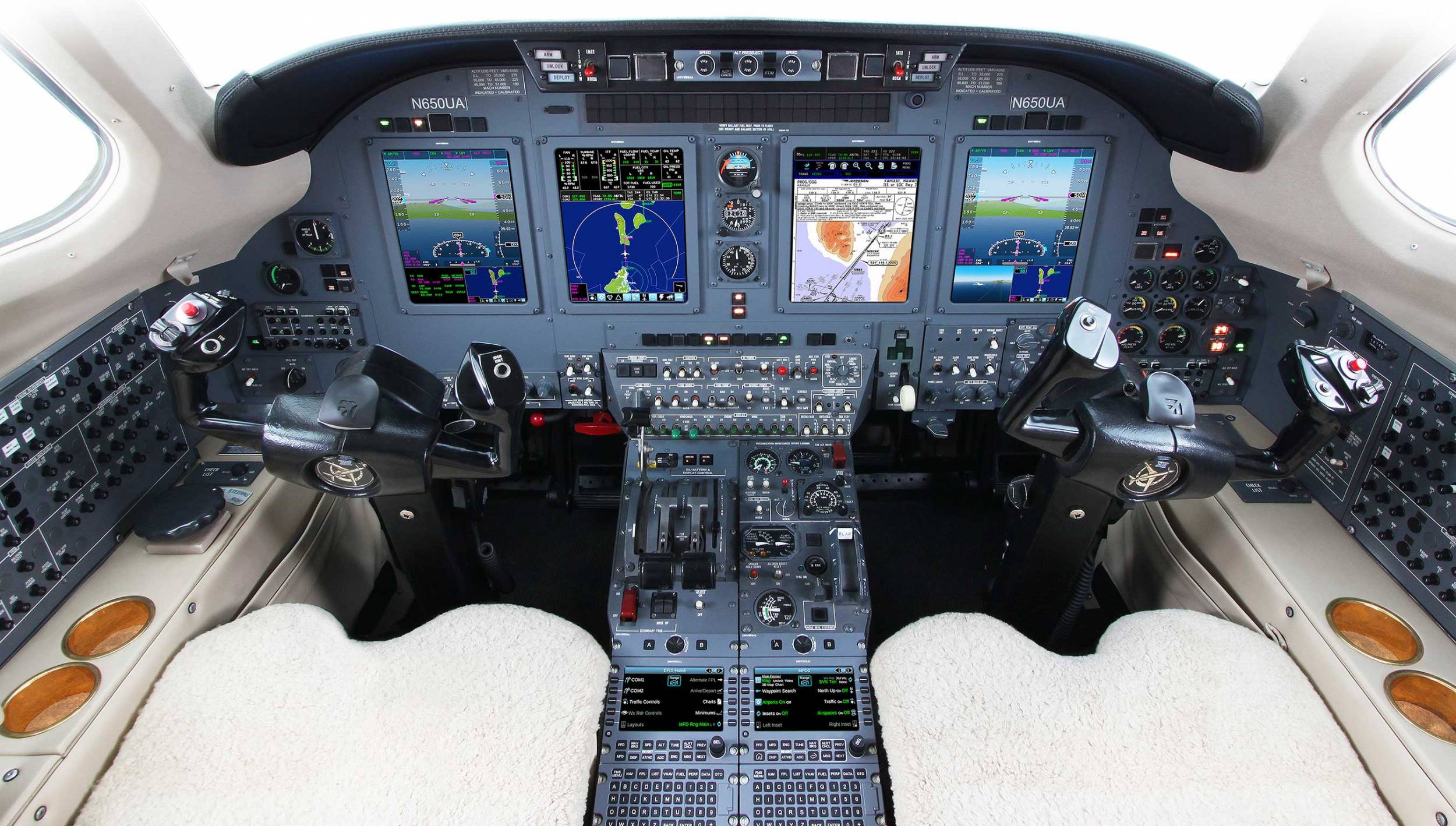Click Here to View This Page on Production Frontend
Click Here to Export Node Content
Click Here to View Printer-Friendly Version (Raw Backend)
Note: front-end display has links to styled print versions.
Content Node ID: 408665
When business jet pilots look at the instrument panels of today’s modern airline jets, they might be surprised to see that the avionics in those airplanes are not the latest and greatest but represent a different approach to providing important information to pilots. Most airliners, for example, even those coming off assembly lines today, do not have synthetic vision, something that has been a staple in business jet flight decks for years. And moving maps on today’s airliners come up way short on detail when compared to a sub-$1,000 Apple iPad running one of the many available moving-map electronic flight bag apps.
This isn’t because Boeing and Airbus and Embraer don’t want to add the latest technology to their products but it has more to do with the way airlines prefer to configure their aircraft. Airline flight decks, for example, are mostly a combination of products from different avionics manufacturers, built to a specification developed by the airframer and its airline customers. And airlines are loath to spend money on unnecessary features, especially if they aren’t mandated by a regulator. Synthetic vision is in this case a “nice to have” feature and isn’t mandated, and thus is subject to being left behind during design decisions. That is despite the fact that many pilots believe synthetic vision is a fantastic situational awareness safety tool.
Fortunately, this isn’t the case with business jets. Perhaps this is because even though pilots aren’t the ones paying for the aircraft, they still have an enormous influence on purchasing decisions, and business jet manufacturers listen closely to pilots and go out of their way to include the latest technology.
The result is that today’s business jet integrated flight decks, with touchscreens, synthetic vision, autothrottles, combined vision head-up displays, simpler, more powerful flight management systems and autopilots, and even autoland systems are the norm and not the exception.

Collins Pro Line Fusion
First out of the gate with touchscreen instrument panel displays, Collins Aerospace’s Pro Line Fusion integrated flight deck pushed the envelope of avionics technology. First available in the King Air line as forward-fit avionics for the Textron Aviation King Air line and in retrofit applications, Pro Line Fusion touchscreen avionics give pilots the option of using touch and familiar gestures or knobs and buttons, depending on their preference.
Collins Aerospace also is one of the few manufacturers of head-up displays and developed a combined vision system (CVS) that overlays synthetic vision and infrared enhanced vision imagery on the head-up display (HUD) combiner. The combined vision HUD is available on Bombardier jets including the Global 7500, 6500, and 5500. One key difference between the Collins CVS and Elbit’s HUD with CVS is that the Collins system combines the synthetic and infrared imagery together into a single image, while the Elbit system (FalconEye in Dassault’s jets) puts both images on the combiner at the same time but connected to each other, not overlaid.
Other than the King Air turboprops, no aircraft manufacturer has yet selected the touchscreen Pro Line Fusion flight deck for any new business jets. So the only way to fly with Pro Line Fusion touch in a jet now is in one of the models in which the avionics are certified for a retrofit. These include the Bombardier Challenger 604 and Cessna Citation CJ1+, CJ2+, and CJ3.
Non-touch Pro Line Fusion systems are factory-standard in the Gulfstream G280, Embraer Praetor 500 and 600, and Global 5500, 6500, and 7500. Some of the features of Pro Line Fusion include 2D airport moving map, electronic checklist, Multi-Scan weather radar with predictive and reactive windshear detection, controller-pilot datalink communications, and graphical flight planning. Pro Line Fusion includes Collins’s patented airport dome, which highlights the airport’s location on the moving map and in synthetic vision imagery to enhance situational awareness.

Garmin G3000/5000
Garmin has made steady inroads into the business jet avionics market with its G3000 (Part 23) and G5000 (Part 25) integrated flight decks. What makes them unique is that Garmin completely bypassed the era of the traditional flight management control and display unit (FMS CDU). The G3000 and G5000 systems are essentially the same from the pilot’s perspective, and what makes them unique is that they were the first application of touchscreen technology in a business jet.
The Garmin touchscreens, however, aren’t the instrument panel primary and multifunction displays (that came later with TXi displays) but are touchscreen controllers, which are the main pilot interface for the avionics.
With its G1000 integrated cockpit avionics for light airplanes (later a popular retrofit for King Airs and factory standard in the Citation Mustang), Garmin advanced the concept of big displays, synthetic vision, and other features that are now standard in most modern aircraft. The G1000 system, while powerful, did require that pilots learn key steps and functions involving a lot of button pushing and knob twisting. Moving the interface to the touchscreen controllers of the G3000/G5000 greatly simplified the operation of the avionics.
The infrared-based 5.7-inch touchscreen controller operates all avionics functions, including audio control/intercom, transponders, radios, satellite communications, electronic checklists, systems synoptics, moving-maps, traffic, weather, and entertainment. Airframe OEMs can opt for customized features too, for example, Cirrus uses one of the three touchscreen controllers in the Vision Jet as a backup display, eliminating the need to install a separate electronic backup instrument.
Entering a flight plan on the Garmin touchscreens is simple; just select departure and destination airports, interim waypoints and airways, and that’s it. No complicated FMS CDU button pushing or step memorization. To set up an approach procedure, touch the procedures icon on the controller, select the approach at the destination, pick the transition, and that’s it.
On most business jet installations, Garmin’s integrated flight decks include takeoff and landing data based on current weather conditions.
Garmin has carved out a significant share of both the forward-fit and aftermarket for its G3000/G5000 integrated flight decks, and pilots at all levels are increasingly likely to be flying behind Garmin avionics. Starting with the G1000 in Cessna and Piper training airplanes, pilots moving up into more advanced aircraft could remain in the Garmin family, including Cirrus SR series piston single-engine airplane, the Vision Jet, Daher’s TBM and Kodiak and Cessna’s Caravan single-engine turboprops, Cessna’s recently certified cargo-hauling SkyCourier twin-turboprop, and most of the Citation series jets currently in production. Many retrofit applications for Garmin integrated cockpits are available, too, including G5000 for the Citation XL/Excel series.

Honeywell Epic and Anthem
Honeywell has long had a lock on the avionics that power some of the most sophisticated business jets available, including Gulfstream’s large-cabin jets and most of Dassault’s Falcon models (all of the modern Falcons with EASy flight decks).
In the Gulfstreams, the Honeywell Primus Epic-based avionics are branded PlaneView and reflect some of the customization chosen by Gulfstream designers for those jets. Likewise, Dassault has customized features of Primus Epic for its EASy avionics suites.
Over the years, as the capabilities of these avionics grew with the range and performance of the aircraft, many aspects of the pilot interface have been improved, although they still rely on a traditional FMS-CDU interface. However, in the latest Gulfstream models starting with the G500 and G600, Gulfstream and Honeywell greatly improved the interface with the addition of touchscreen controllers. In the latest Falcon models, the EASy interface has also been improved, with simpler phase-based flight planning functions and less reliance on the CDU for inputting information.
Although Honeywell has tried to create an ecosystem around its Primus Epic and Apex avionics (Apex is installed in new Pilatus PC-12s and PC-24s) and its BendixKing family for light aircraft, the two brands never synched. Honeywell hasn’t been successful in the retrofit market that Garmin has penetrated so deeply. For example, the AeroVue flight deck for the King Air that Honeywell certified is basically dormant as there was apparently very little market interest in the system. Although as capable as the most modern Primus Epic flight deck, AeroVue turned out to be too expensive when compared to Garmin G1000 upgrades.
But Honeywell is fighting back and has finally developed a new avionics system—Anthem—that will be available and cost-effective for everything from an electric advanced aerial mobility aircraft to light airplanes and helicopters, turboprops, and light, midsize, and large business jets as well as airliners. So far two eVTOL developers have selected Anthem, Lilium and Vertical Aerospace.
Anthem is an avionics platform that allows pilots to plan and set up flights using Honeywell’s Forge app on a smart device and communicate remotely with a secure onboard server on the aircraft. This allows for offline flight planning, avionics setup, and monitoring of aircraft systems from an FBO, hotel, home, or office.
Once onboard, the pilot interface is three touchscreen displays (customizable by the airframe OEM, of course), and these are the actual primary and multifunction displays, not just touchscreen controllers, although there is also a pilot interface display unit that acts as a controller as well.
A unique feature of Anthem that no other avionics manufacturer offers is the secure cockpit browser, which is a window on the center touchscreen display. Almost any web application can run on the browser—for example, web versions of ForeFlight, Windy, Universal Weather, and NOAA weather, as well as FAA weather camera feeds and company manuals and documents.
The advantage here is that pilots can access these applications whenever the aircraft is connected to the internet, right on their instrument panel, without having to pull out a tablet and connect it to the internet.
Honeywell has incorporated full taxi guidance into Anthem’s Taxi Assist, with both the 3D and 2D views that are currently available in some Honeywell-equipped business jets, as well as step-by-step routing.
Once in the air, Anthem has a position trend vector that indicates where the aircraft will end up, for example, while turning and taking wind into account. Traffic is displayed on both the moving map on the center display and also on the primary display, but a new feature with Anthem is that the PFD depiction is conformal.
Traffic targets are shown tethered to the ground, making it easier to interpret the target’s location and distance, using the distance markers on the synthetic vision display. Because the target is conformal, the pilot can use the flight path vector (FPV) on the PFD to ensure clearance; if the FPV isn’t pointed at the target, then there won’t be a collision.
Waypoints depicted on the conformal synthetic vision are also tethered to the ground and are called “3D waypoints.” The distance markers again make it easy for the pilot to see a 3D waypoint’s location, instead of looking at the moving map or a waypoint list in the flight plan.
The conformality also helps improve situational awareness because the pilot can immediately see how the aircraft relates to a waypoint or other element.
The Mission Manager is at the heart of Anthem, giving pilots a simple timeline depiction of all the events for a flight. It can be expanded from a simple flight plan with route elements like departure, airways, and destination or showing all elements and waypoints. But helpfully, Mission Manager shows the number of minutes to each event instead of what most flight planning systems show: the time of arrival at each event.
Even more helpful is that checklists are integrated with Mission Manager because, after all, they are events on the timeline too. So when it is appropriate for a checklist to appear, say the pre-landing checklist, it will be an event on the timeline. Touching that event brings up the checklist.
Pilots will also be able to set triggers that appear in the timeline—for example, if ATC issues an instruction to contact the tower five miles from the airport, that trigger will automatically pop up a reminder for the pilot at that point.
When connected to the internet, pilots can also send and receive information via Forge—for example, a notification to the company’s dispatchers about the aircraft’s location. Or the dispatcher could send a message to the pilots.

Universal Avionics InSight
Universal Avionics has made major headways into the retrofit market with its integrated InSight Display System flight deck. The system is available now for Falcon 50 and 900 models as well as the Hawker 800 and Citation VII. Universal has also extensively modified its Gulfstream III for use as a flying demonstrator for all of its technologies, including the InSight flight deck and ClearVision enhanced flight vision system (EFVS) with EVS-5000 camera system and SkyLens head-wearable display.
Pilots familiar with Universal’s FMS will be immediately comfortable with the InSight system, which shares many of the same interface conventions. But InSight also offers buyers options for more modern touchscreens, with the EFIS CDU available in touch or non-touch configurations. This can be paired with a cursor-control device and alphanumeric keyboard for those who prefer these kind of interfaces. Radio and transponder functions can be done through the EFIS CDU or also using the cursor on the moving-map display.
When it comes to installation of an InSight system, the avionics shop has access to Universal’s external configuration editor, which simplifies setup of the avionics configuration for that particular aircraft. Configurations can be saved and shared so that work doesn’t have to be replicated for a particular aircraft model.
InSight brings all the modern capabilities to bear, including LPV approaches, performance-based navigation, controller-pilot data link communications, FANS 1/A+, FAA Data Comm, and electronic charts. Also included is Universal’s pioneering synthetic vision system; it was the first company to offer synthetic vision to the business aviation market.
The synthetic vision graphics for InSight include high-resolution graphics with runway depiction, terrain, ice and water features, airport maps with ramps, terminal buildings, taxiways, and hold short lines, and outlines of urban areas.
Universal Avionics, which is owned by Israel’s Elbit, is the only other manufacturer making head-up displays for the business aviation market. While Elbit’s HUD isn’t yet available for a retrofit in the business jets with InSight approvals, it could be done if a customer really wanted that capability. However, HUDs are expensive and take up a lot of space in flight decks, and Universal Avionics has solved that problem with the SkyLens head-wearable display.
Certification and installation of SkyLens is far simpler as there is no bulky projector to install on the ceiling of the flight deck. And because SkyLens is worn by the pilot, it offers a distinct advantage over a traditional HUD that has a limited field of view straight ahead. No matter which direction the pilot is looking, SkyLens can display the synthetic vision outside view, greatly improving situational awareness. With Universal’s “gaze selection,” using a button on the yoke and the cursor inside the SkyLens view, the pilot can interact with outside elements that are in view such as waypoints and manage the FMS to set up an approach, change routing, or select a different runway.
SkyLens with Universal’s ClearVision EFVS is certified in the ATR 42 and 72 regional turboprops, but expect to see some business jet approvals based on the company’s experience flying SkyLens in its Gulfstream III demonstrator.